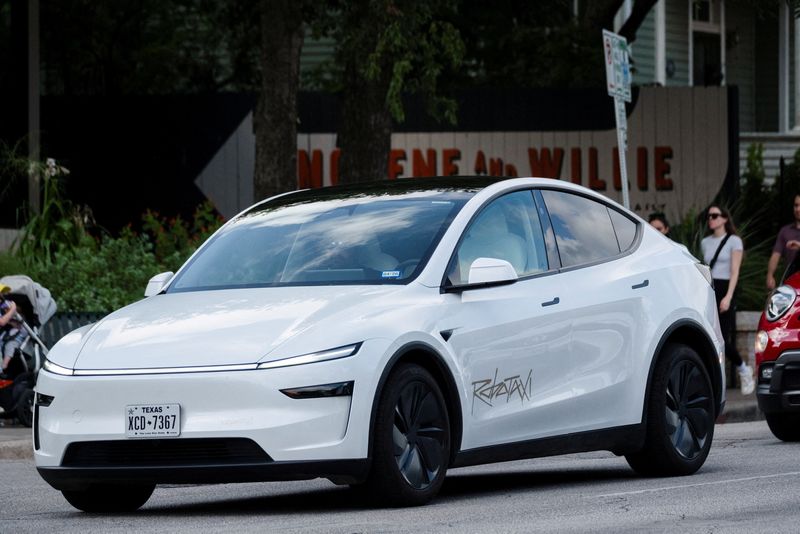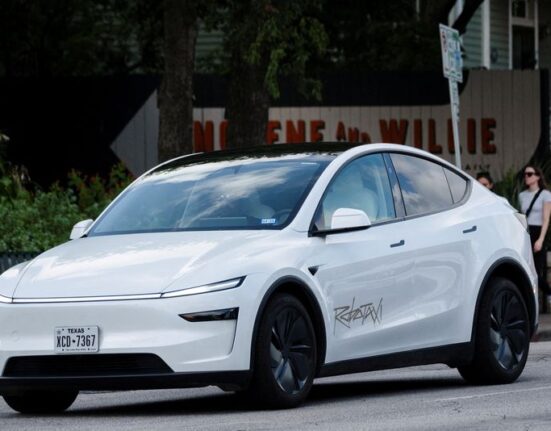(Reuters) –Tesla reported record third-quarter revenue, beating Wall Street estimates on Wednesday, driven by the highest quarterly sales of its electric vehicles as car buyers rushed to lock in a key U.S. tax credit ahead of its expiry last month.
The $7,500 tax credit had been a driver of EV sales, and the industry is bracing for a drop in demand through the rest of the year. Tesla did not provide a full-year forecast.
“While we face near-term uncertainty from shifting trade, tariff and fiscal policy, we are focused on long-term growth and value creation,” the company said in a shareholder update on Wednesday. Shares of the Austin, Texas-based company were down about 2% in extended trading.
The electric vehicle maker reported total revenue of $28.1 billion for the third quarter ended September 30, compared with analysts’ average estimate of $26.37 billion, according to data compiled by LSEG.
Profit per share in the third quarter was 50 cents, below analysts’ estimates of 55 cents.
Tesla reported gross margin of 18%, compared with estimates of 17.5%. Its closely watched automotive gross margin, excluding regulatory credits, was 15.4%, compared with an average estimate of 15.6%, according to 19 analysts polled by Visible Alpha.
Tesla’s limited rollout of its self-driving “robotaxi” service in Austin, Texas, earlier this year marked a key strategic pivot, underpinning investor expectations that the company will transition from pure vehicle sales to focusing on self-driving technology.
While most of Tesla’s current revenue is still derived from vehicle sales, its $1.45 trillion valuation largely reflects investor bets on robotics and AI.
Tesla introduced lower-cost “Standard” variants of Model Y and Model 3 vehicles earlier this month as part of a volume-growth push, cutting features and prices to make the vehicles more accessible after the expiration of the U.S. tax credit on EV purchases.
A rush in the U.S. to grab the federal incentive before it went away at the end of September resulted in the company delivering a record number of vehicles in the third quarter.
While Tesla hopes the cheaper variants will drive higher volumes, analysts warn the move will squeeze margins as thousands of dollars of cost cuts per vehicle may not fully compensate for lower selling prices.
Wall Street expects Tesla’s deliveries in 2025 to fall 8.5% due to the expiry of the tax credit, reliance on older models and rising competition. Tesla CEO Elon Musk’s embrace of right-wing politics has also alienated some potential buyers.
(Reuters) –Tesla reported record third-quarter revenue, beating Wall Street estimates on Wednesday, driven by the highest quarterly sales of its electric vehicles as car buyers rushed to lock in a key U.S. tax credit ahead of its expiry last month.
The $7,500 tax credit had been a driver of EV sales, and the industry is bracing for a drop in demand through the rest of the year. Tesla did not provide a full-year forecast.
“While we face near-term uncertainty from shifting trade, tariff and fiscal policy, we are focused on long-term growth and value creation,” the company said in a shareholder update on Wednesday. Shares of the Austin, Texas-based company were down about 2% in extended trading.
The electric vehicle maker reported total revenue of $28.1 billion for the third quarter ended September 30, compared with analysts’ average estimate of $26.37 billion, according to data compiled by LSEG.
Profit per share in the third quarter was 50 cents, below analysts’ estimates of 55 cents.
Tesla reported gross margin of 18%, compared with estimates of 17.5%. Its closely watched automotive gross margin, excluding regulatory credits, was 15.4%, compared with an average estimate of 15.6%, according to 19 analysts polled by Visible Alpha.
Tesla’s limited rollout of its self-driving “robotaxi” service in Austin, Texas, earlier this year marked a key strategic pivot, underpinning investor expectations that the company will transition from pure vehicle sales to focusing on self-driving technology.
While most of Tesla’s current revenue is still derived from vehicle sales, its $1.45 trillion valuation largely reflects investor bets on robotics and AI.
Tesla introduced lower-cost “Standard” variants of Model Y and Model 3 vehicles earlier this month as part of a volume-growth push, cutting features and prices to make the vehicles more accessible after the expiration of the U.S. tax credit on EV purchases.
A rush in the U.S. to grab the federal incentive before it went away at the end of September resulted in the company delivering a record number of vehicles in the third quarter.
While Tesla hopes the cheaper variants will drive higher volumes, analysts warn the move will squeeze margins as thousands of dollars of cost cuts per vehicle may not fully compensate for lower selling prices.
Wall Street expects Tesla’s deliveries in 2025 to fall 8.5% due to the expiry of the tax credit, reliance on older models and rising competition. Tesla CEO Elon Musk’s embrace of right-wing politics has also alienated some potential buyers.












Leave feedback about this